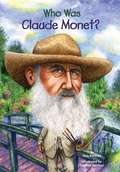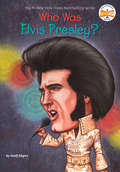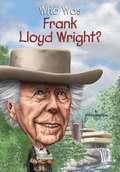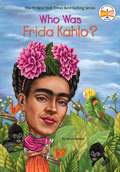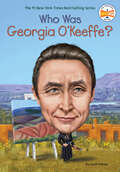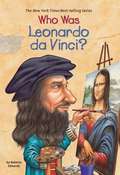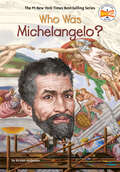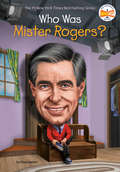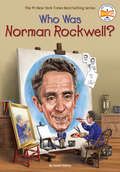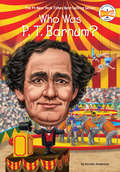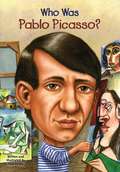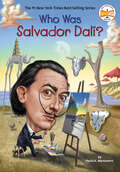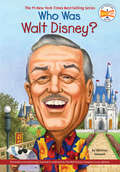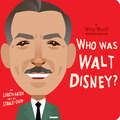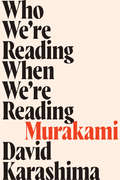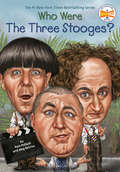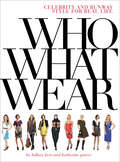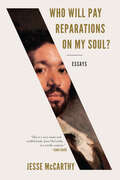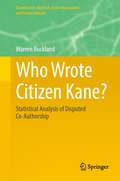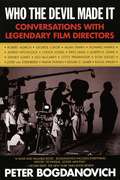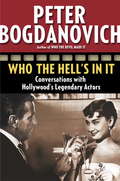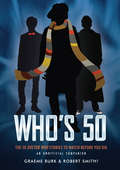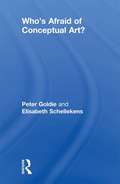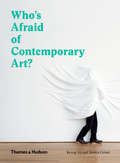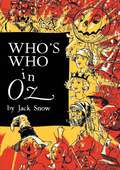- Table View
- List View
Who Was Claude Monet? (Who was?)
by Ann WaldronClaude Monet is considered one of the most influential artists of all time. He is a founder of the French Impressionist art movement, and today his paintings sell for millions of dollars. While Monet was alive, however, his work was often criticized and he struggled financially. This book unveils a true portrait of the artist!
Who Was Elvis Presley? (Who Was?)
by Geoff Edgers John O'BrienPut on your blue suede shoes and get ready for another addition to the Who Was…? series! The King could not have come from humbler origins: Born in Tupelo, Mississippi, during the Depression, he grew up with the blues music of the rural South, the gospel music of local churches, and the country-western classics. But he forged a sound all his own—and a look that was all his own, too. With curled lip, swiveling hips, and greased pompadour, Elvis changed popular music forever, ushering in the age of rock and roll. Geoff Edgers’s fascinating biography of this icon of American pop culture includes black and- white illustrations on nearly every spread.
Who Was Frank Lloyd Wright? (Who was?)
by Nancy Harrison Gregory Copeland Ellen LabrecqueBorn in Wisconsin in 1867, Frank Lloyd Wright became obsessed with a set of building blocks his mother had given to him on his ninth birthday. He grew up to become the father of organic architecture and the greatest American architect of all time, having designed more than 1,100 buildings during his lifetime. These included private homes - such as the stunning Fallingwater, churches, temples, a hotel, and the world-famous Guggenheim Museum in New York City. When asked how he could create so many designs, he answered, "I can't get them out fast enough." Frank Lloyd Wright was a man ahead of his time who could barely keep up with his own ideas!
Who Was Frida Kahlo? (Who was?)
by Jerry Hoare Sarah FabinyYou can always recognize a painting by Kahlo because she is in nearly all--with her black braided hair and colorful Mexican outfits. A brave woman who was an invalid most of her life, she transformed herself into a living work of art. As famous for her self-portraits and haunting imagery as she was for her marriage to another famous artist, Diego Rivera, this strong and courageous painter was inspired by the ancient culture and history of her beloved homeland, Mexico. Her paintings continue to inform and inspire popular culture around the world.
Who Was Georgia O'Keeffe? (Who Was?)
by Sarah Fabiny Who HQDiscover how a little girl raised on a dairy farm grew up to become the first woman ever to have an exhibition of their entire life&’s work at the Museum of Modern Art in this addition to the #1 New York Times bestselling Who Was series.Georgia O'Keeffe is famously known for her colorful, large paintings of flowers, but this artist's portfolio expands far beyond Jack-in-the-pulpits. In this book, young readers will learn about O'Keeffe's childhood in Wisconsin and her years as a talented art school teacher. Her years as an artist in both New York and New Mexico, two areas that are heavily represented in her artwork, reveal O'Keeffe's influences. Explore the adventures that inspired O'Keeffe's paintings of skyscrapers, barns, skulls, flowers, and made her into an American art icon of the twentieth century.
Who Was Leonardo Da Vinci?
by Roberta EdwardsLeonardo da Vinci was a gifted painter, talented musician, and dedicated scientist and inventor, designing flying machines, submarines, and even helicopters. Yet he had a hard time finishing things, a problem anyone can relate to. Only thirteen paintings are known to be his; as for the illustrated encyclopaedia he intended to create, all that he left were thousands of disorganised notebook pages. Here is an accessible portrait of a fascinating man who lived at a fascinating time - Italy during the Renaissance.
Who Was Michelangelo? (Who Was?)
by Kirsten Anderson Who HQTravel to Renaissance Italy and learn about the young apprentice who went on become a true master, and one of the most beloved sculptors and painters of all time in this addition to the #1 New York Times Best-Selling Who Was? series!Michelangelo created some of the world's most recognizable art, from the statue of David to the intricate ceiling fresco of the Sistine Chapel. Beyond his well-known painting and sculpting, he was a gifted poet and architect. Young readers can learn about the entirety of Michelangelo's life, from his time as a young apprentice, his relationships with several Catholic popes and the Medici family, to his unwillingness to stop working into his late eighties. A perfect read for art lovers and fans of the Renaissance.
Who Was Mister Rogers? (Who Was?)
by Diane Bailey Who HQLearn how Fred Rogers, a minister and musician from Pennsylvania, became one of America's most beloved television personalities and everyone's favorite neighbor.Even though he's best known for his successful PBS series Mister Rogers' Neighborhood, Fred Rogers never dreamed of working in television. In fact, he hated the very first program that he ever watched! Join author Diane Bailey as she takes readers through the journey that brought Mister Rogers into our living rooms. From his childhood interest in puppet-making and music, to his courageous visit to Russia during the Cold War, this book details Mister Rogers's quest for kindness and his gentle appeal to be more neighborly.
Who Was Norman Rockwell? (Who Was?)
by Sarah Fabiny Who HQBrush up your knowledge on popular American painter and illustrator Norman Rockwell with this exciting Who Was? title.Norman Rockwell often painted what he saw around him in nostalgic and humorous ways. After hearing President Franklin Roosevelt's address to Congress in 1943, he was inspired to create paintings that described the principles for universal rights: four paintings that portray iconic images of the American experience. Over the course of his lifetime, he painted 322 covers for the Saturday Evening Post. Of his work, he has said: "Maybe as I grew up and found the world wasn't the perfect place I thought it to be, I consciously decided that if it wasn't an ideal world, it should be, and so painted only the ideal aspects of it."
Who Was P. T. Barnum? (Who Was?)
by Kirsten Anderson Who HQLadies and Gentlemen, children of all ages, step right up for Who HQ's entertaining biography of P. T. Barnum: politician, businessman, and The Greatest Showman on Earth!After moving from Connecticut to New York City in 1834, twenty-four-year-old Phineas Taylor Barnum launched his now-legendary career as a showman. Even though spectators debated whether his exhibitions were authentic wonders, hoaxes, or a little bit of both, they were always astounded by what they saw. And readers are sure to be amazed by the story of how Barnum went from owning a museum filled with rare and unusual items to transforming the American circus into a popular and thrilling phenomenon.
Who Was Pablo Picasso? (Who was?)
by True KelleyOver a long, turbulent life, Picasso continually discovered new ways of seeing the world and translating it into art. A restless genius, he went through a blue period, a rose period, and a Cubist phase. He made collages, sculptures out of everyday objects, and beautiful ceramic plates. True Kelley's engaging biography is a wonderful introduction to modern art.
Who Was Salvador Dalí? (Who Was?)
by Paula K. Manzanero Who HQLearn about the fascinating career of surrealist Salvador Dalí from his early life in Spain through his public life as an internationally famous artist in this exciting addition to the #1 New York Times Best-Selling series.Most famous for his surrealist painting The Persistence of Memory and its melting clocks, Salvador Dalí combined his dreamlike ideas with his excellent technical skills to become one of the most famous artists of the twentieth century. Beyond painting, Dalí pursued the arts in many other mediums including sculpture, film, fashion, photography, architecture, and more. He was friends with many of his famous contemporaries, including Picasso, Bunuel, Miro, and Duchamp. Learn about the sometimes-shy man with the instantly recognizable upturned mustache in this book for young readers that details the life of one of modern art's most celebrated figures.
Who Was Walt Disney? (Who Was?)
by Whitney Stewart Nancy HarrisonWalt Disney always loved to entertain people. Often it got him into trouble. Once he painted pictures with tar on the side of his family's white house. His family was poor, and the happiest time of his childhood was spent living on a farm in Missouri. His affection for small-town life is reflected in Disneyland Main Streets around the world. With black-and-white illustrations throughout, this biography reveals the man behind the magic.This book is not authorized, licensed or endorsed by the Walt Disney Company or any affiliate.From the Trade Paperback edition.
Who Was Walt Disney?: A Who Was? Board Book (Who Was? Board Books)
by Who HQ Lisbeth KaiserThe latest addition to the Who HQ board book series: a biography of Walt Disney, created specifically for the preschool audience!The #1 New York Times Bestselling Who Was? series expands into the board book space, bringing age-appropriate biographies of influential figures to readers ages 2-4.The chronology and themes of Walt Disney's inspiring life are presented in a masterfully succinct text, with just a few sentences per page. The fresh, stylized illustrations are sure to captivate young readers and adults alike. With a read-aloud biographical summary in the back, this age-appropriate introduction shares the life and work of one of the most influential creators and entertainers of our time.WHO WAS? BOARD BOOKS bring inspiring biographies to the youngest readers in an accessible and memorable way.
Who We're Reading When We're Reading Murakami
by David KarashimaHow did a loner destined for a niche domestic audience become one of the most famous writers alive? A "fascinating" look at the "business of bringing a best-selling novelist to a global audience" (The Atlantic)―and a “rigorous” exploration of the role of translators and editors in the creation of literary culture (The Paris Review). Thirty years ago, when Haruki Murakami’s works were first being translated, they were part of a series of pocket-size English-learning guides released only in Japan. Today his books can be read in fifty languages and have won prizes and sold millions of copies globally. How did a loner destined for a niche domestic audience become one of the most famous writers alive? This book tells one key part of the story. Its cast includes an expat trained in art history who never intended to become a translator; a Chinese American ex-academic who never planned to work as an editor; and other publishing professionals in New York, London, and Tokyo who together introduced a pop-inflected, unexpected Japanese voice to the wider literary world. David Karashima synthesizes research, correspondence, and interviews with dozens of individuals—including Murakami himself—to examine how countless behind-the-scenes choices over the course of many years worked to build an internationally celebrated author’s persona and oeuvre. His careful look inside the making of the “Murakami Industry" uncovers larger questions: What role do translators and editors play in framing their writers’ texts? What does it mean to translate and edit “for a market”? How does Japanese culture get packaged and exported for the West?
Who Were The Three Stooges?
by Pam Pollack Meg BelvisoDiscover more about the comedy team that perfected the art of the pie fight!The Three Stooges were the hardworking children of immigrants and discovered a love of performing at an early age. Starting out as a vaudeville act, they soon transitioned into movies, becoming a worldwide sensation in feature films and shorts. Never the critics' darlings, audiences loved them for their mastery of physical comedy and their willingness to do anything for a laugh. They remained popular over the years despite several personnel changes that revolved around the three Howard brothers from Brooklyn. Their comedies are still in syndication more than 50 years after they were first shown on TV and continue to delight old fans and attract new ones.
Who What Wear: Celebrity and Runway Style for Real Life
by Hillary Kerr Katherine PowerA smart and stylish fashion and beauty guide from the creators of the popular website WhoWhatWear.com. The founders of WhoWhatWear.com share their tricks of the trade, translating high fashion in a low-fuss, accessible way. Hillary Kerr and Katherine Power, two former Elle magazine editors, are the fashionable duo behind the booming website. In Who What Wear they&’ve compiled the best of their tips and advice into one stylish compendium. Trends come and go at a dizzying pace and it can be challenging to just get dressed in the morning! Kerr and Power banish those fashion faux-pas fears and give readers the tools necessary to update their own personal styles and recognize and incorporate the latest runway and Hollywood looks. Celebrity contributors such as Rachel Zoe, Nicole Richie, and Rachel Bilson also dish their insider-style secrets alongside images from the runway and beyond. &“Who What Wear is a dream for every aspiring fashionista . . . it helps make fashion accessible to everyone.&” —Rachel Zoe &“WhoWhatWear.com is one of my favorite fashion sites . . . you can spend hours on the site—I do.&” —Nicole Richie
Who Will Pay Reparations on My Soul?: Essays
by Jesse McCarthy"This is a very smart and soulful book. Jesse McCarthy is a terrific essayist." —Zadie Smith New York Times • "New Books to Watch For in March" A supremely talented young critic’s essays on race and culture, from Toni Morrison to trap, herald the arrival of a major new voice in American letters. Ranging from Ta-Nehisi Coates’s case for reparations to Toni Morrison’s revolutionary humanism to D’Angelo’s simmering blend of R&B and racial justice, Jesse McCarthy’s bracing essays investigate with virtuosic intensity the art, music, literature, and political stances that have defined the twenty-first century. Even as our world has suffered through successive upheavals, McCarthy contends, “something was happening in the world of culture: a surging and unprecedented visibility at every level of black art making.” Who Will Pay Reparations on My Soul? reckons with this resurgence, arguing for the central role of art and intellectual culture in an age of widening inequality and moral crisis. McCarthy reinvigorates the essay form as a space not only for argument but for experimental writing that mixes and chops the old ways into new ones. In “Notes on Trap,” he borrows a conceit from Susan Sontag to reveal the social and political significance of trap music, the drug-soaked strain of Southern hip-hop that, as he puts it, is “the funeral music that the Reagan Revolution deserves.” In “Back in the Day,” McCarthy, a black American raised in France, evokes his childhood in Paris through an elegiac account of French rap in the 1990s. In “The Master’s Tools,” the relationship between Spanish painter Diego Velázquez and his acolyte-slave, Juan de Pareja, becomes the lens through which Kehinde Wiley’s paintings are viewed, while “To Make a Poet Black” explores the hidden blackness of Sappho and the erotic power of Phillis Wheatley. Essays on John Edgar Wideman, Claudia Rankine, and Colson Whitehead survey the state of black letters. In his title essay, McCarthy takes on the question of reparations, arguing that true progress will not come until Americans remake their institutions in the service of true equality. As he asks, “What can reparations mean when the damage cannot be accounted for in the only system of accounting that a society recognizes?” For readers of Teju Cole’s Known and Strange Things and Mark Greif’s Against Everything, McCarthy’s essays portray a brilliant young critic at work, making sense of our disjointed times while seeking to transform our understanding of race and art, identity and representation.
Who Wrote Citizen Kane?: Statistical Analysis of Disputed Co-Authorship (Quantitative Methods in the Humanities and Social Sciences)
by Warren BucklandThis book offers a solution to one of film history’s major controversies: the long-running dispute over Orson Welles’ and Herman J. Mankiewicz’s contributions to the Citizen Kane screenplay. It establishes the vital importance of computing and statistics to solving previously intractable puzzles in the arts and humanities. Citizen Kane (1941) is one of the most acclaimed films in the history of cinema. For 50 years it topped the Sight & Sound film critics’ poll. Orson Welles directed the film and is credited with co-writing the screenplay with Herman J. Mankiewicz. But the co-writer credit generates furious disputes between those who argue Mankiewicz is the sole author of Citizen Kane and those who claim that Welles collaborated fully with its writing. The author employs computing and statistics to answer two questions: What are the distinguishing features of Welles’ and of Mankiewicz’s writing? And What did each contribute to the writing of the Citizen Kane screenplay? To answer these questions, the author bypasses opinions and impressions, and instead subjects the language of the Citizen Kane screenplay to a ‘forensic’ examination. Employing linguistics, basic statistical tests, plus computer technology and software, the author identifies the stylistic signature of each author – the combination of consistent and regular linguistic habits that make each author’s writing distinctive. This book replaces impressionistic discussions of Mankiewicz’s and Welles’ contributions to the Citizen Kane screenplay with a rigorous, experiment-driven statistical analysis. Earlier statistical studies of authorship have discovered that small, unassuming language features (such as punctuation, pronouns, and prepositions) in statistically significant quantities, constitute a screenwriter’s distinctive writing habits. Only with the extensive experimentation carried out in this volume, did the author decide Mankiewicz’s and Welles’ specific habits and their contributions to Citizen Kane.
Who the Devil Made It: Conversations with Legendary Film Directors
by Peter BogdanovichIn this fascinating chronicle of Hollywood and the grand art of making movies, Peter Bogdanovich--director, screenwriter, actor, and critic--interviews sixteen legendary directors of the first hundred years of film: Robert Aldrich George Cukor Allan Dwan Howard Hawks Alfred Hitchcock Chuck Jones Fritz Lang Joseph H. Lewis Sidney Lumet Leo McCartey Otto Preminger Don Siegel Josef von Sternberg Frank Tashlin Edgar G. Ulmer Raoul Walsh
Who the Hell's in It: Conversations with Hollywood's Legendary Actors
by Peter BogdanovichPeter Bogdanovich, known primarily as a director, film historian and critic, has been working with professional actors all his life. He started out as an actor (he debuted on the stage in his sixth-grade production of Finian's Rainbow); he watched actors work (he went to the theater every week from the age of thirteen and saw every important show on, or off, Broadway for the next decade); he studied acting, starting at sixteen, with Stella Adler (his work with her became the foundation for all he would ever do as an actor and a director).Now, in his new book, Who the Hell's in It, Bogdanovich draws upon a lifetime of experience, observation and understanding of the art to write about the actors he came to know along the way; actors he admired from afar; actors he worked with, directed, befriended. Among them: Lauren Bacall, Humphrey Bogart, James Cagney, John Cassavetes, Charlie Chaplin, Montgomery Clift, Marlene Dietrich, Henry Fonda, Ben Gazzara, Audrey Hepburn, Boris Karloff, Dean Martin, Marilyn Monroe, River Phoenix, Sidney Poitier, Frank Sinatra, and James Stewart.Bogdanovich captures--in their words and his--their work, their individual styles, what made them who they were, what gave them their appeal and why they've continued to be America's iconic actors.On Lillian Gish: "the first virgin hearth goddess of the screen . . . a valiant and courageous symbol of fortitude and love through all distress." On Marlon Brando: "He challenged himself never to be the same from picture to picture, refusing to become the kind of film star the studio system had invented and thrived upon--the recognizable human commodity each new film was built around . . . The funny thing is that Brando's charismatic screen persona was vividly apparent despite the multiplicity of his guises . . . Brando always remains recognizable, a star-actor in spite of himself. " Jerry Lewis to Bogdanovich on the first laugh Lewis ever got onstage: "I was five years old. My mom and dad had a tux made--I worked in the borscht circuit with them--and I came out and I sang, 'Brother, Can You Spare a Dime?' the big hit at the time . . . It was 1931, and I stopped the show--naturally--a five-year-old in a tuxedo is not going to stop the show? And I took a bow and my foot slipped and hit one of the floodlights and it exploded and the smoke and the sound scared me so I started to cry. The audience laughed--they were hysterical . . . So I knew I had to get the rest of my laughs the rest of my life, breaking, sitting, falling, spinning."John Wayne to Bogdanovich, on the early years of Wayne's career when he was working as a prop man: "Well, I've naturally studied John Ford professionally as well as loving the man. Ever since the first time I walked down his set as a goose-herder in 1927. They needed somebody from the prop department to keep the geese from getting under a fake hill they had for Mother Machree at Fox. I'd been hired because Tom Mix wanted a box seat for the USC football games, and so they promised jobs to Don Williams and myself and a couple of the players. They buried us over in the properties department, and Mr. Ford's need for a goose-herder just seemed to fit my pistol."These twenty-six portraits and conversations are unsurpassed in their evocation of a certain kind of great movie star that has vanished. Bogdanovich's book is a celebration and a farewell.From the Hardcover edition.
Who's 50: The 50 Doctor Who Stories to Watch Before You Die
by Robert Smith Graeme Burk&“Like being thrown the keys to the TARDIS with a temporal map to visit all those not-to-be-missed adventures in time and space&” (Phil Ford, Doctor Who writer). Ever since its premiere on November 23, 1963, Doctor Who has been a television phenomenon. This companion guide presents the top fifty stories from the show&’s first fifty years—examining every corner of the imaginative, humorous, and sometimes scary universe that has made Doctor Who an iconic part of popular culture. This must-have reference also includes behind the scenes details, goofs, trivia, connections to Doctor Who lore, and much more.
Who's Afraid of Conceptual Art?
by Peter Goldie Elisabeth SchellekensWhat is conceptual art? Is it really a kind of art in its own right? Is it clever – or too clever? Of all the different art forms it is perhaps conceptual art which at once fascinates and infuriates the most. In this much-needed book Peter Goldie and Elisabeth Schellekens demystify conceptual art using the sharp tools of philosophy. They explain how conceptual art is driven by ideas rather than the manipulation of paint and physical materials; how it challenges the very basis of what we can know about art, as well as our received ideas of beauty; and why conceptual art requires us to rethink concepts fundamental to art and aesthetics, such as artistic interpretation and appreciation. Including helpful illustrations of the work of celebrated conceptual artists from Marcel Duchamp, Joseph Kosuth and Piero Manzoni to Dan Perjovschi and Martin Creed, Who’s Afraid of Conceptual Art? is a superb starting point for anyone intrigued but perplexed by conceptual art - and by art in general. It will be particularly helpful to students of philosophy, art and visual studies seeking an introduction not only to conceptual art but fundamental topics in art and aesthetics.
Who's Afraid of Contemporary Art?
by Jessica Cerasi Kyung AnA smart and playful introduction to the often-mystifying world of contemporary art What is contemporary art? What makes it contemporary? What is it for? And why is it so expensive? From museums and the art market to biennales and the next big thing, Who’s Afraid of Contemporary Art? offers concise and pointed insights into today’s art scene, decoding “Artspeak," explaining what curators do, demystifying conceptual art, exploring emerging art markets, and more. In this easy-to-navigate A to Z guide, the authors’ playful explanations draw on key artworks, artists, and events from around the globe, including how the lights going on and off won the Turner Prize, what makes the likes of Marina Abramovic and Ai Weiwei such great artists, and why Kanye West would trade his Grammys to be one. Packed with behind-the-scenes information and completely free of jargon, Who’s Afraid of Contemporary Art? is the perfect gallery companion and the go to guide for when the next big thing leaves you stumped.
Who's Who In Oz
by Jack SnowJack Snow’s Who’s Who in Oz is the ultimate companion to the magical land of Oz, offering readers a comprehensive and enchanting guide to the characters, places, and lore of L. Frank Baum’s beloved fantasy world. Perfect for longtime fans and newcomers alike, this reference book delves deep into the rich tapestry of Oz, providing detailed profiles and fascinating insights into its vibrant and imaginative universe.Organized alphabetically, the book introduces readers to an array of characters—from Dorothy, the Scarecrow, and the Tin Woodman to lesser-known yet equally intriguing figures like Kabumpo the Elegant Elephant and the Patchwork Girl. Each entry includes vivid descriptions, backstories, and connections to the larger narrative, making it easy to explore the magical land in all its glory.In addition to character profiles, Snow expands on the geography and history of Oz, highlighting its fantastical locations, unique customs, and the stories that have made it a timeless realm of wonder. With Snow’s expertise and dedication to Baum’s original vision, Who’s Who in Oz is both a loving tribute and an essential resource for anyone captivated by the world over the rainbow.Illustrated and meticulously researched, this book is a must-have for Oz enthusiasts, collectors, and anyone seeking to deepen their appreciation for one of the most iconic fantasy settings in literature. Who’s Who in Oz is not just a guide—it’s a magical journey back to the heart of a world that continues to inspire generations.
